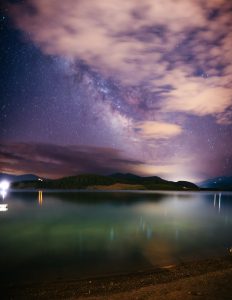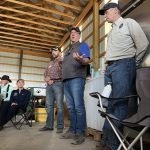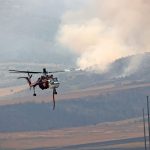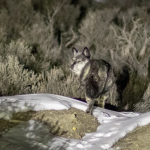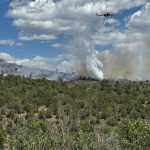How to view the Perseids meteor shower — with up to 150 shooting stars per hour — in Colorado’s mountains
Comfortable summer temperatures should make for good stargazing during one of the best meteor showers of the year, according to a mountain astronomy guide

Colton Sturgeon/Courtesy photo
Colorado’s night skies will be filled with hundreds of shooting stars this month as one of the best meteor showers of the year rains down on the Rocky Mountains.
Astronomy guide Mark Laurin — better known as Astro Mark — said the Perseids meteor shower will dazzle stargazers with an estimated 150 shooting stars per hour when it peaks on the night of Aug. 12.
“This is supposed to be the granddaddy of them all,” Laurin said of the meteor shower, noting that it is just one of several astronomical phenomena that Colorado residents and visitors can witness during August.
A mountain town resident and member of the Denver Astronomical Society, Laurin said August is among the best months for stargazing in Colorado. In addition to looking for shooting stars, he said stargazers this month can stare into the galactic center of the Milky Way, spot asterisms like the Summer Triangle and watch planets align in the night sky.
Now that it’s August, it’s more than a month past the summer solstice, so the sun is setting earlier every day, Laurin said. That means the nights are also getting longer, which allows stargazing to commence earlier.
But it’s also still summer, so it’s warm enough to lie beneath the stars. While there may be hints of winter’s approach in the air, Laurin said in August, “You’re comfortable enough, you’re not freezing, you don’t have to put your down jacket on and you can stay out a while.”
Laurin, who teaches about astronomy in conjunction with the Colorado Tourism Center and as an adjunct instructor for the Keystone Science School, recommended spending time under the stars with friends and family before summer is over. So, find a dark spot with a good view of the sky, put the cellphone away and look up, he said.
“Just take five minutes and look at the stars. Notice the difference in color. The difference in brightness,” Laurin said. “That’s all it takes to get the fullness of what the stars have to offer. If you go look for five minutes, you’re going to end up looking for 10 minutes because the universe draws you in.”
Here are some celestial sights to keep an eye out for in August:
Perseids meteor shower
While there is a chance that a shooting star could dart across the sky on any clear, dark night, meteor showers offer the best opportunity to see shooting stars — and the Perseids meteor shower is one of the best of the year.
A meteor, often called a “shooting star,” is the bright streak of light seen when a small piece of space debris burns up in the atmosphere, Laurin said. A meteor shower occurs when the Earth’s orbit passes through a stream of debris left by a comet, causing a shower of shooting stars as the debris burns up in the atmosphere.
The Perseids meteor shower began in mid-July and will peak in mid-August. The meteor shower is named for the constellation Perseus, the radiant point from which the shooting stars will appear to originate, although Laurin said meteors will “come from all over the sky.” For the best view of the meteor shower, look upwards anywhere with a wide view of the sky, he said.
Earlier in the evening, Laurin said stargazers are likely to see more “streakers” that will create long streaks across the sky, but later into the evening and early morning, there will be more “explosive events,” like “fireballs,” where the shooting star appears to burst with light.
Though the meteor shower will peak on the night of Aug. 12, Laurin said stargazers will be contending with a “pretty bright waning gibbous moon” that night that could block out some of the fainter meteors. He said his “pro tip” would be to get out on the night of Aug. 11, about two hours after sunset, when the moon will still be below the horizon, so the night sky will be darker and the meteor shower more luminous.
But with the Perseids, Laurin said all one has to do is get outside, look up on a clear night anytime in August and there’s a good chance of seeing a shooting star.
“I’ve never met a person who saw a meteor and didn’t have to point it out. Never. Never in my life,” Laurin said. “The finger goes up, ‘Look at that!’ Every time. That’s why I do this. Because for me, it’s about when people experience the mystery of the universe and they go ‘Wow! Holy smokes! Look at that!'”
Planetary alignment
For early risers, Aug. 12 will offer celestial “bookends,” Laurin said, with planets aligning across the sky before dawn and the Perseids meteor shower peaking at the end of the day, after the sun sets.
To catch the planetary alignment, where Mercury, Jupiter, Venus and Saturn will form a straight line across the sky, visible to the naked eye, Laurin said Coloradans will need to rise before dawn, perhaps around 5:30 a.m. with “a cup of coffee to clear your head.”
Look to the east to find Mercury, which shines like a star but, like other planets, doesn’t twinkle. Mercury will be just a little above the horizon, Laurin said. Jupiter and Venus will be just above Mercury in the east.
From there, draw a line across the center of the sky to the moon on the western horizon. Saturn, the fourth planet in the alignment, will be just to the left of the moon, Laurin said. If Saturn is hard to see, close one eye and stretch out a hand to cover the moon to block out some of its light, he said.
With binoculars, Neptune can also be seen. “You can’t miss it,” Laurin said. It will be right next to Saturn, and “it’s distinctly blue,” he said.
The Milky Way
Throughout the entire month of August, the Milky Way — the barred spiral galaxy which our solar system is a part of — will stretch north to south across the night skies. For all of human existence, people have stared at this dense band of stars in awe, Laurin said. “The Milky Way,” he said, “was the original nocturnal entertainment.”
While light pollution has muddied out the Milky Way in cities, Colorado’s mountains help to block out artificial light, so on dark, clear nights it is possible to share the same view of the stars that our ancestors had, Laurin said. Admire not only the shimmering brightness of the stars but the empty space between them, like the Great Rift, a band of darkness where “dark nebulosity, dust, hydrogen, helium” and space gases are so thick that they obscure light from passing through, he said.
Lying on their backs, stargazers can also begin to spot asterisms — or groups of stars of similar brightness that form a pattern or shape — as they familiarize themselves with the night sky, Laurin said.
Asterisms, which are often part of larger constellations, are usually named after the shape created by the stars. The Big Dipper, for example, is one of the best-known asterisms in the night sky.
In August, Laurin said stargazers can find the Summer Triangle, an asterism composed of three stars that form a triangle, by facing south and looking directly up at the highest point in the sky. The Summer Triangle includes stars that are part of the constellations of Aquila (the eagle), Cygnus (the swan) and Lyra (the Lyre).
With the Perseids meteor shower this month and dueling meteor showers still ongoing after peaking last month, Laurin said anyone who spends just a little time in August staring at the night sky is sure to see something spectacular.
“That’s what makes this time of year so special. It’s so rich,” Laurin said. “The Milky Way is in an opportunistic position, you have these meteor showers that have been going on for almost two months now, and it’s capped by the Perseids.”

Support Local Journalism

Support Local Journalism
Readers around Glenwood Springs and Garfield County make the Post Independent’s work possible. Your financial contribution supports our efforts to deliver quality, locally relevant journalism.
Now more than ever, your support is critical to help us keep our community informed about the evolving coronavirus pandemic and the impact it is having locally. Every contribution, however large or small, will make a difference.
Each donation will be used exclusively for the development and creation of increased news coverage.

